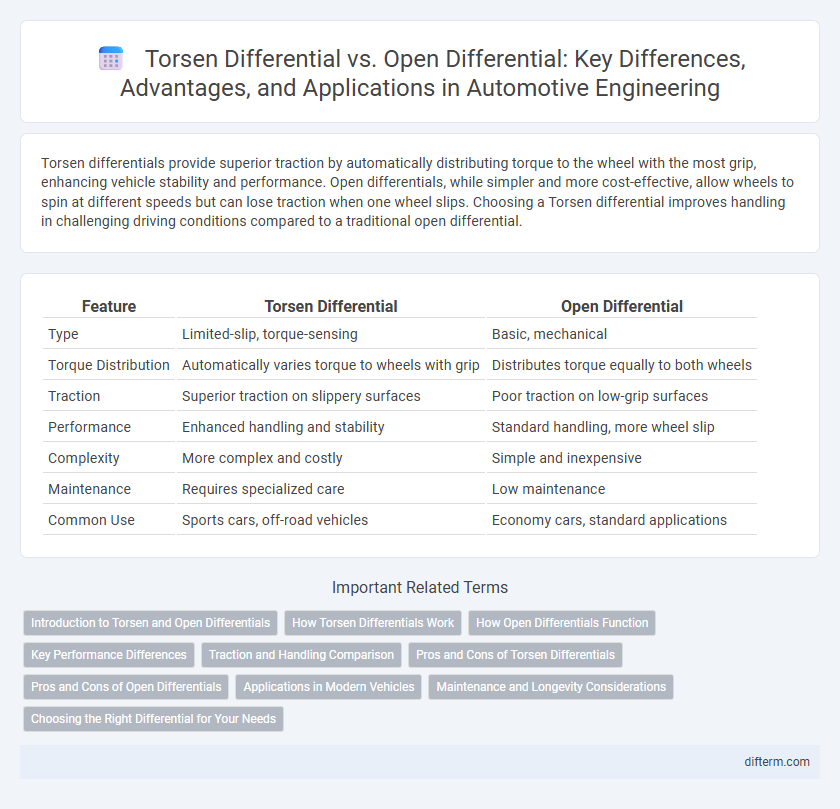Torsen differentials provide superior traction by automatically distributing torque to the wheel with the most grip, enhancing vehicle stability and performance. Open differentials, while simpler and more cost-effective, allow wheels to spin at different speeds but can lose traction when one wheel slips. Choosing a Torsen differential improves handling in challenging driving conditions compared to a traditional open differential.
Table of Comparison
| Feature | Torsen Differential | Open Differential |
|---|---|---|
| Type | Limited-slip, torque-sensing | Basic, mechanical |
| Torque Distribution | Automatically varies torque to wheels with grip | Distributes torque equally to both wheels |
| Traction | Superior traction on slippery surfaces | Poor traction on low-grip surfaces |
| Performance | Enhanced handling and stability | Standard handling, more wheel slip |
| Complexity | More complex and costly | Simple and inexpensive |
| Maintenance | Requires specialized care | Low maintenance |
| Common Use | Sports cars, off-road vehicles | Economy cars, standard applications |
Introduction to Torsen and Open Differentials
Torsen differentials utilize a worm gear mechanism to actively distribute torque between wheels, enhancing traction and stability during varying road conditions. Open differentials allow wheels to rotate at different speeds but send equal torque to each side, often leading to reduced traction on slippery surfaces. The Torsen design provides superior handling performance by automatically biasing torque towards wheels with better grip, unlike the simple torque split of open differentials.
How Torsen Differentials Work
Torsen differentials use a set of helical gears to distribute torque between wheels based on traction conditions, providing automatic torque biasing without electronic intervention. Unlike open differentials, which split torque evenly and can cause wheel slip, Torsen differentials transfer more torque to the wheel with better grip, enhancing vehicle stability and performance in varied driving conditions. This mechanical design improves traction and handling by dynamically adjusting torque distribution according to wheel resistance.
How Open Differentials Function
Open differentials distribute engine torque equally to both wheels while allowing them to rotate at different speeds, essential during cornering to prevent tire slip. They use a set of gears that balance torque but cannot prevent wheel spin on low-traction surfaces, resulting in reduced traction. This contrasts with Torsen differentials, which actively transfer torque to the wheel with more grip, enhancing vehicle stability and performance.
Key Performance Differences
A Torsen differential provides superior traction by automatically distributing torque to the wheel with the most grip, enhancing stability and handling in various driving conditions compared to an open differential that evenly splits torque regardless of wheel slip. The open differential often results in power loss when one wheel loses traction, limiting performance on slippery or uneven surfaces. Torsen's internal gear mechanism delivers improved cornering, reduced wheel spin, and better acceleration, making it ideal for high-performance and off-road vehicles.
Traction and Handling Comparison
Torsen differentials provide superior traction by automatically distributing torque to the wheel with the most grip, enhancing stability on slippery or uneven surfaces compared to open differentials that evenly split torque regardless of wheel slip. This torque-sensing capability improves handling during cornering by reducing understeer and wheel spin, resulting in more precise and responsive vehicle dynamics. Vehicles equipped with Torsen differentials maintain better control and acceleration in challenging driving conditions, making them favored in performance and off-road applications.
Pros and Cons of Torsen Differentials
Torsen differentials offer superior torque transfer capabilities by distributing power dynamically to the wheels with the most traction, enhancing vehicle stability and performance in low-grip conditions. They provide improved handling compared to open differentials, which can lead to wheel slippage and loss of control when torque is unevenly applied. However, Torsen differentials tend to be more complex, heavier, and costly, potentially increasing vehicle price and maintenance requirements.
Pros and Cons of Open Differentials
Open differentials provide smooth power distribution to both wheels, improving handling on dry, paved roads and reducing tire wear. They offer simplicity, lower cost, and easier maintenance compared to Torsen differentials but can cause traction loss on slippery or uneven surfaces as power is sent to the wheel with less grip. This limitation makes open differentials less ideal for off-road driving or high-performance vehicles requiring better torque management.
Applications in Modern Vehicles
Torsen differentials are predominantly used in high-performance and all-wheel-drive (AWD) vehicles for enhanced traction and stability, especially in sports cars like the Audi Quattro and off-road SUVs. Open differentials are commonly found in economy and passenger cars due to their simplicity and cost-effectiveness but are less effective in low-traction conditions. Modern vehicles increasingly favor Torsen differentials for improved torque distribution and handling in diverse driving environments.
Maintenance and Longevity Considerations
Torsen differentials require less frequent maintenance compared to open differentials due to their robust internal gearing system, which reduces wear under high torque conditions. The longevity of Torsen differentials is enhanced by their ability to evenly distribute torque, minimizing stress on drivetrain components and extending overall service life. Open differentials, while simpler, often experience faster wear and require more regular inspection and lubrication to maintain optimal performance.
Choosing the Right Differential for Your Needs
Torsen differentials offer superior torque distribution by automatically transferring power to the wheel with more grip, enhancing traction and stability in demanding driving conditions. Open differentials, while simpler and more cost-effective, distribute power evenly but can lead to wheel spin on slippery surfaces. Selecting the right differential depends on driving style and terrain, with Torsen being ideal for performance and off-road vehicles where traction is critical.
Torsen differential vs open differential Infographic

 difterm.com
difterm.com